CHRYSLER PT CRUISER 2008 1.G Owners Manual
Manufacturer: CHRYSLER, Model Year: 2008, Model line: PT CRUISER, Model: CHRYSLER PT CRUISER 2008 1.GPages: 491, PDF Size: 7.08 MB
Page 301 of 491
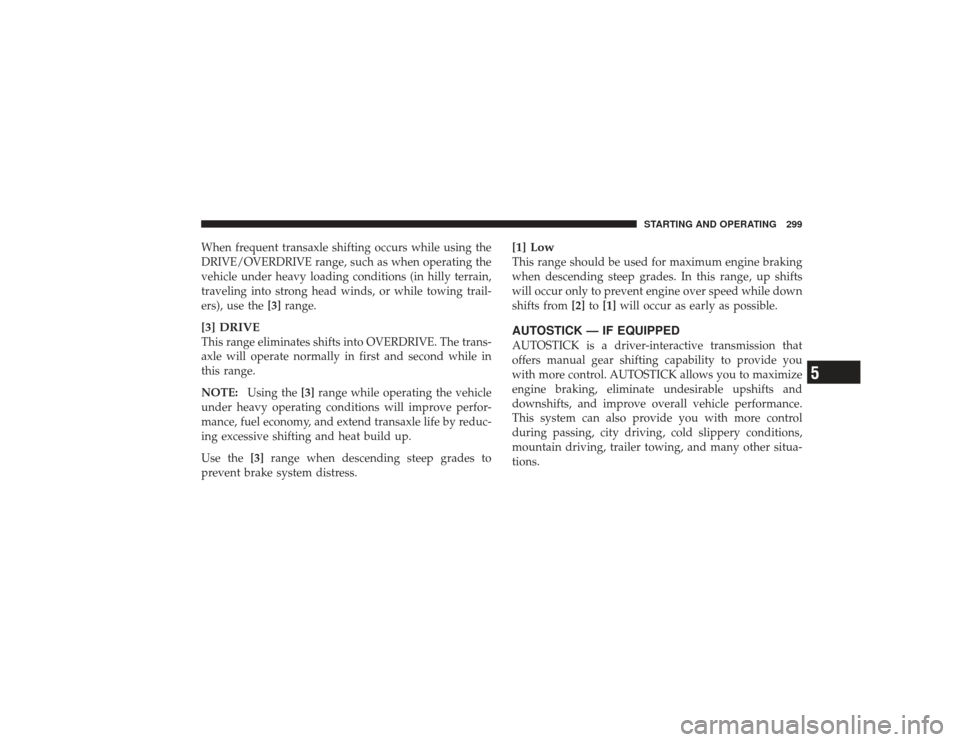
When frequent transaxle shifting occurs while using the
DRIVE/OVERDRIVE range, such as when operating the
vehicle under heavy loading conditions (in hilly terrain,
traveling into strong head winds, or while towing trail-
ers), use the[3]range.[3] DRIVEThis range eliminates shifts into OVERDRIVE. The trans-
axle will operate normally in first and second while in
this range.
NOTE: Using the [3]range while operating the vehicle
under heavy operating conditions will improve perfor-
mance, fuel economy, and extend transaxle life by reduc-
ing excessive shifting and heat build up.
Use the [3]range when descending steep grades to
prevent brake system distress.
[1] LowThis range should be used for maximum engine braking
when descending steep grades. In this range, up shifts
will occur only to prevent engine over speed while down
shifts from [2]to[1] will occur as early as possible.AUTOSTICK — IF EQUIPPEDAUTOSTICK is a driver-interactive transmission that
offers manual gear shifting capability to provide you
with more control. AUTOSTICK allows you to maximize
engine braking, eliminate undesirable upshifts and
downshifts, and improve overall vehicle performance.
This system can also provide you with more control
during passing, city driving, cold slippery conditions,
mountain driving, trailer towing, and many other situa-
tions.
STARTING AND OPERATING 299
5
Page 302 of 491
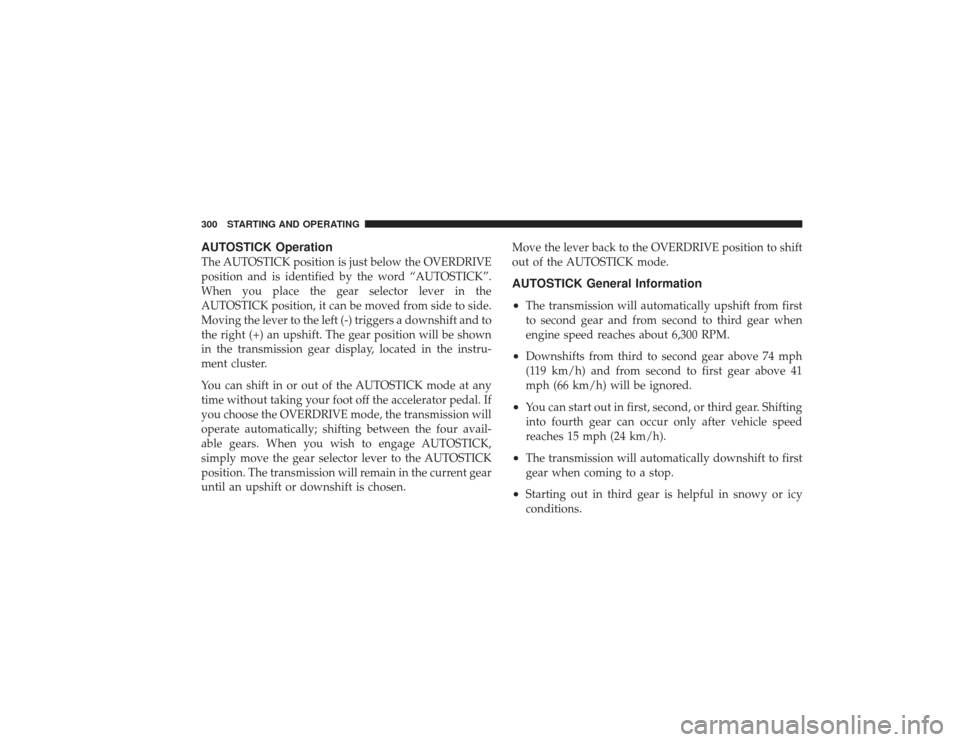
AUTOSTICK OperationThe AUTOSTICK position is just below the OVERDRIVE
position and is identified by the word “AUTOSTICK”.
When you place the gear selector lever in the
AUTOSTICK position, it can be moved from side to side.
Moving the lever to the left (-) triggers a downshift and to
the right (+) an upshift. The gear position will be shown
in the transmission gear display, located in the instru-
ment cluster.
You can shift in or out of the AUTOSTICK mode at any
time without taking your foot off the accelerator pedal. If
you choose the OVERDRIVE mode, the transmission will
operate automatically; shifting between the four avail-
able gears. When you wish to engage AUTOSTICK,
simply move the gear selector lever to the AUTOSTICK
position. The transmission will remain in the current gear
until an upshift or downshift is chosen.Move the lever back to the OVERDRIVE position to shift
out of the AUTOSTICK mode.
AUTOSTICK General Information
•
The transmission will automatically upshift from first
to second gear and from second to third gear when
engine speed reaches about 6,300 RPM.
•
Downshifts from third to second gear above 74 mph
(119 km/h) and from second to first gear above 41
mph (66 km/h) will be ignored.
•
You can start out in first, second, or third gear. Shifting
into fourth gear can occur only after vehicle speed
reaches 15 mph (24 km/h).
•
The transmission will automatically downshift to first
gear when coming to a stop.
•
Starting out in third gear is helpful in snowy or icy
conditions.
300 STARTING AND OPERATING
Page 303 of 491
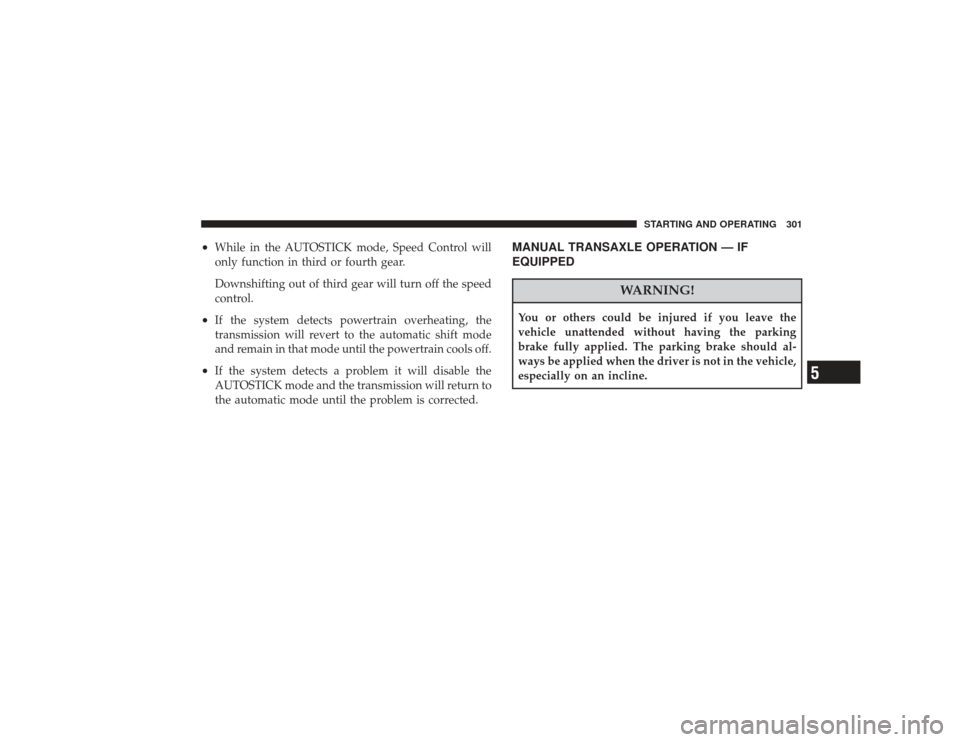
•
While in the AUTOSTICK mode, Speed Control will
only function in third or fourth gear.
Downshifting out of third gear will turn off the speed
control.
•
If the system detects powertrain overheating, the
transmission will revert to the automatic shift mode
and remain in that mode until the powertrain cools off.
•
If the system detects a problem it will disable the
AUTOSTICK mode and the transmission will return to
the automatic mode until the problem is corrected.
MANUAL TRANSAXLE OPERATION — IF
EQUIPPED
WARNING!
You or others could be injured if you leave the
vehicle unattended without having the parking
brake fully applied. The parking brake should al-
ways be applied when the driver is not in the vehicle,
especially on an incline.
STARTING AND OPERATING 301
5
Page 304 of 491
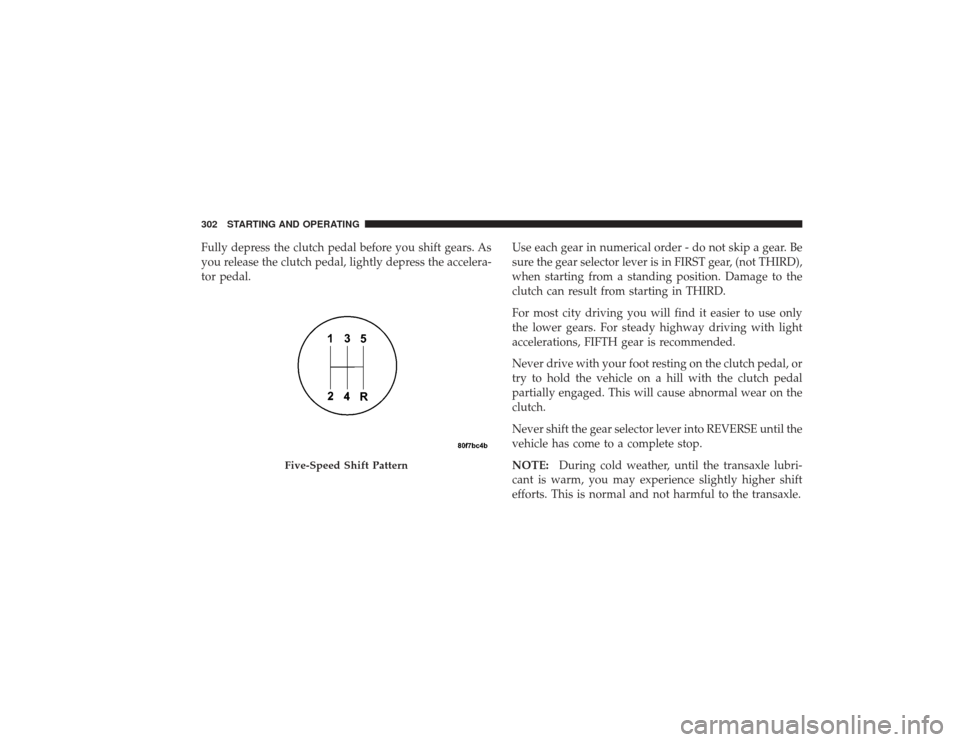
Fully depress the clutch pedal before you shift gears. As
you release the clutch pedal, lightly depress the accelera-
tor pedal.Use each gear in numerical order - do not skip a gear. Be
sure the gear selector lever is in FIRST gear, (not THIRD),
when starting from a standing position. Damage to the
clutch can result from starting in THIRD.
For most city driving you will find it easier to use only
the lower gears. For steady highway driving with light
accelerations, FIFTH gear is recommended.
Never drive with your foot resting on the clutch pedal, or
try to hold the vehicle on a hill with the clutch pedal
partially engaged. This will cause abnormal wear on the
clutch.
Never shift the gear selector lever into REVERSE until the
vehicle has come to a complete stop.
NOTE:
During cold weather, until the transaxle lubri-
cant is warm, you may experience slightly higher shift
efforts. This is normal and not harmful to the transaxle.
Five-Speed Shift Pattern
302 STARTING AND OPERATING
Page 305 of 491
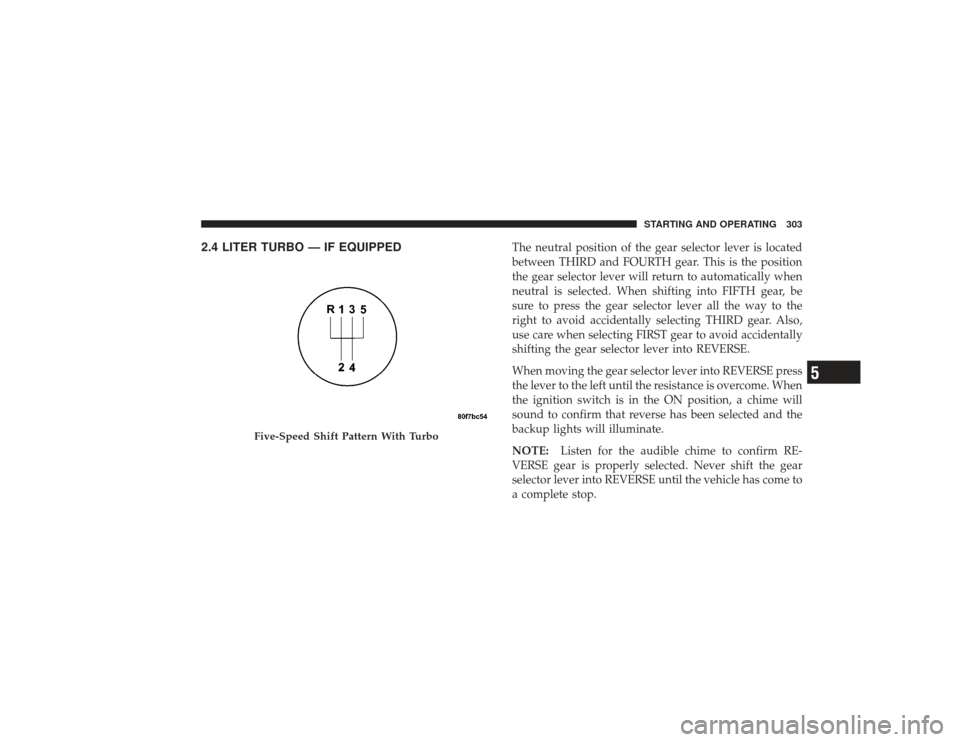
2.4 LITER TURBO — IF EQUIPPED
The neutral position of the gear selector lever is located
between THIRD and FOURTH gear. This is the position
the gear selector lever will return to automatically when
neutral is selected. When shifting into FIFTH gear, be
sure to press the gear selector lever all the way to the
right to avoid accidentally selecting THIRD gear. Also,
use care when selecting FIRST gear to avoid accidentally
shifting the gear selector lever into REVERSE.
When moving the gear selector lever into REVERSE press
the lever to the left until the resistance is overcome. When
the ignition switch is in the ON position, a chime will
sound to confirm that reverse has been selected and the
backup lights will illuminate.
NOTE:Listen for the audible chime to confirm RE-
VERSE gear is properly selected. Never shift the gear
selector lever into REVERSE until the vehicle has come to
a complete stop.
Five-Speed Shift Pattern With Turbo
STARTING AND OPERATING 303
5
Page 306 of 491
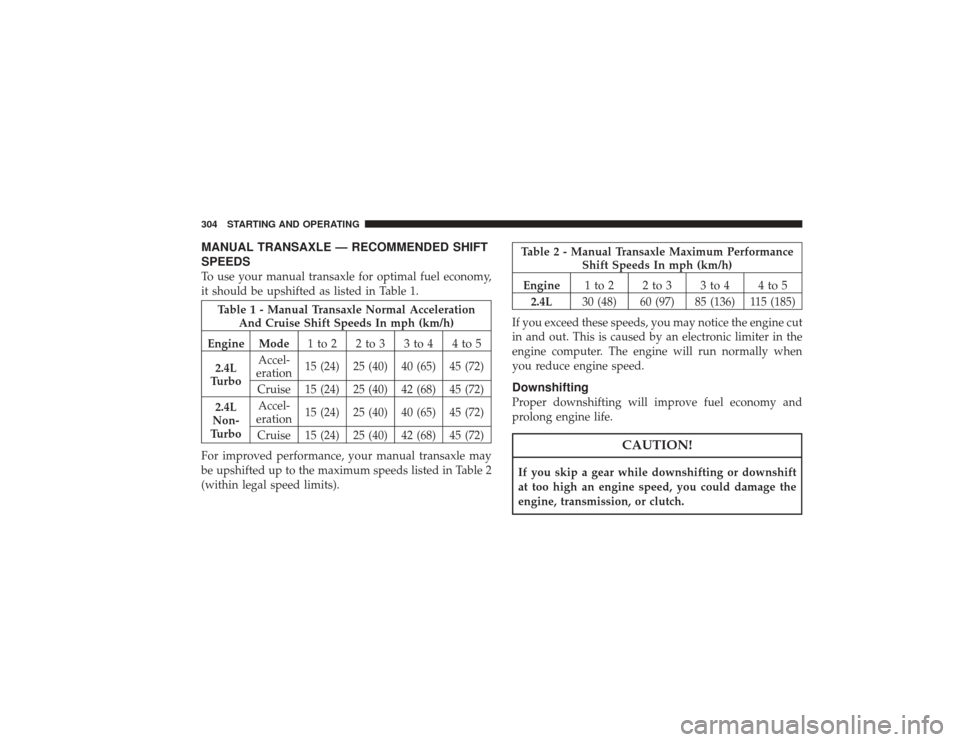
MANUAL TRANSAXLE — RECOMMENDED SHIFT
SPEEDSTo use your manual transaxle for optimal fuel economy,
it should be upshifted as listed in Table 1.
Table 1 - Manual Transaxle Normal AccelerationAnd Cruise Shift Speeds In mph (km/h)
Engine Mode 1to2 2to3 3to4 4to5
2.4L
Turbo Accel-
eration 15 (24) 25 (40) 40 (65) 45 (72)
Cruise 15 (24) 25 (40) 42 (68) 45 (72)
2.4L
Non-
Turbo Accel-
eration 15 (24) 25 (40) 40 (65) 45 (72)
Cruise 15 (24) 25 (40) 42 (68) 45 (72)
For improved performance, your manual transaxle may
be upshifted up to the maximum speeds listed in Table 2
(within legal speed limits).
Table 2 - Manual Transaxle Maximum Performance Shift Speeds In mph (km/h)
Engine 1to2 2to3 3to4 4to5
2.4L 30 (48) 60 (97) 85 (136) 115 (185)
If you exceed these speeds, you may notice the engine cut
in and out. This is caused by an electronic limiter in the
engine computer. The engine will run normally when
you reduce engine speed.DownshiftingProper downshifting will improve fuel economy and
prolong engine life.
CAUTION!
If you skip a gear while downshifting or downshift
at too high an engine speed, you could damage the
engine, transmission, or clutch.
304 STARTING AND OPERATING
Page 307 of 491
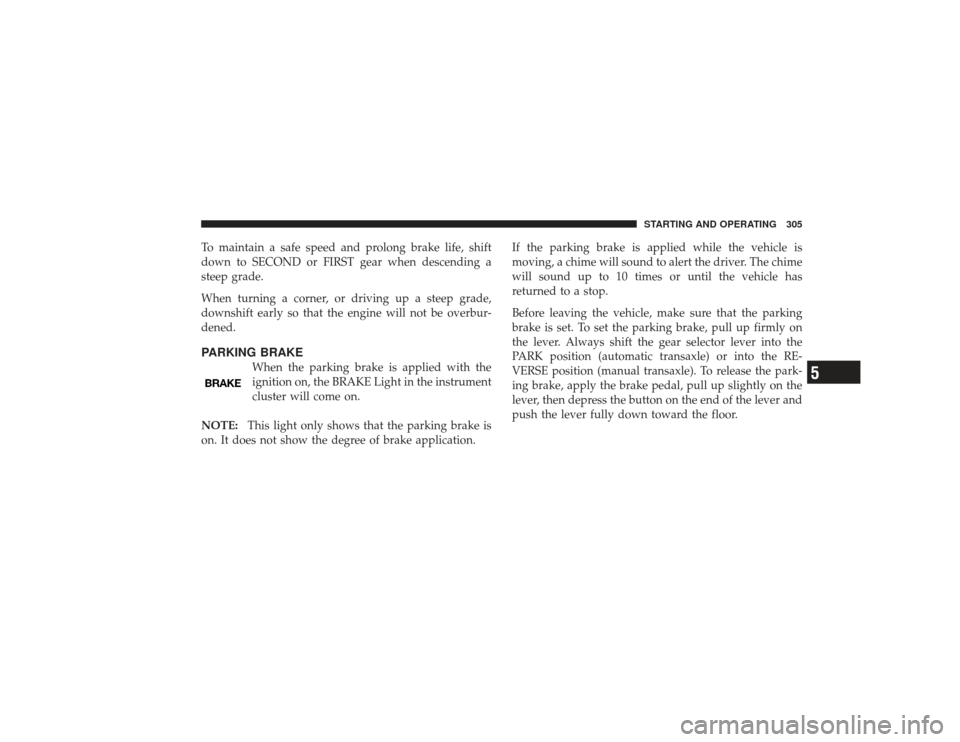
To maintain a safe speed and prolong brake life, shift
down to SECOND or FIRST gear when descending a
steep grade.
When turning a corner, or driving up a steep grade,
downshift early so that the engine will not be overbur-
dened.PARKING BRAKE
When the parking brake is applied with the
ignition on, the BRAKE Light in the instrument
cluster will come on.
NOTE: This light only shows that the parking brake is
on. It does not show the degree of brake application. If the parking brake is applied while the vehicle is
moving, a chime will sound to alert the driver. The chime
will sound up to 10 times or until the vehicle has
returned to a stop.
Before leaving the vehicle, make sure that the parking
brake is set. To set the parking brake, pull up firmly on
the lever. Always shift the gear selector lever into the
PARK position (automatic transaxle) or into the RE-
VERSE position (manual transaxle). To release the park-
ing brake, apply the brake pedal, pull up slightly on the
lever, then depress the button on the end of the lever and
push the lever fully down toward the floor.
STARTING AND OPERATING 305
5
Page 308 of 491
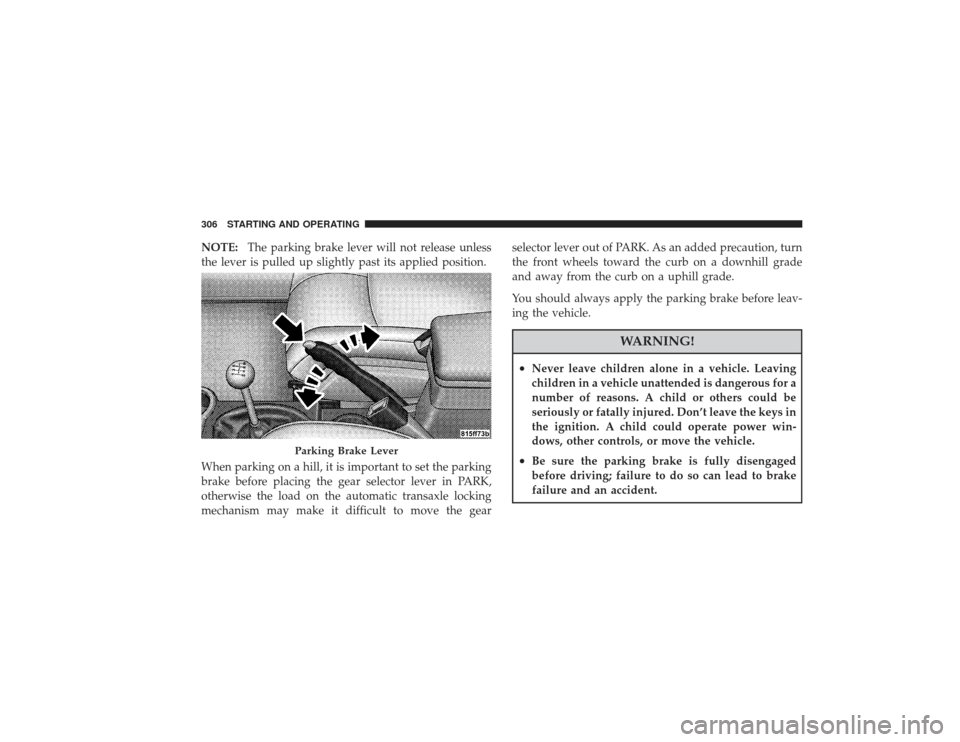
NOTE:The parking brake lever will not release unless
the lever is pulled up slightly past its applied position.
When parking on a hill, it is important to set the parking
brake before placing the gear selector lever in PARK,
otherwise the load on the automatic transaxle locking
mechanism may make it difficult to move the gear selector lever out of PARK. As an added precaution, turn
the front wheels toward the curb on a downhill grade
and away from the curb on a uphill grade.
You should always apply the parking brake before leav-
ing the vehicle.
WARNING!
•
Never leave children alone in a vehicle. Leaving
children in a vehicle unattended is dangerous for a
number of reasons. A child or others could be
seriously or fatally injured. Don’t leave the keys in
the ignition. A child could operate power win-
dows, other controls, or move the vehicle.
•
Be sure the parking brake is fully disengaged
before driving; failure to do so can lead to brake
failure and an accident.
Parking Brake Lever
306 STARTING AND OPERATING
Page 309 of 491
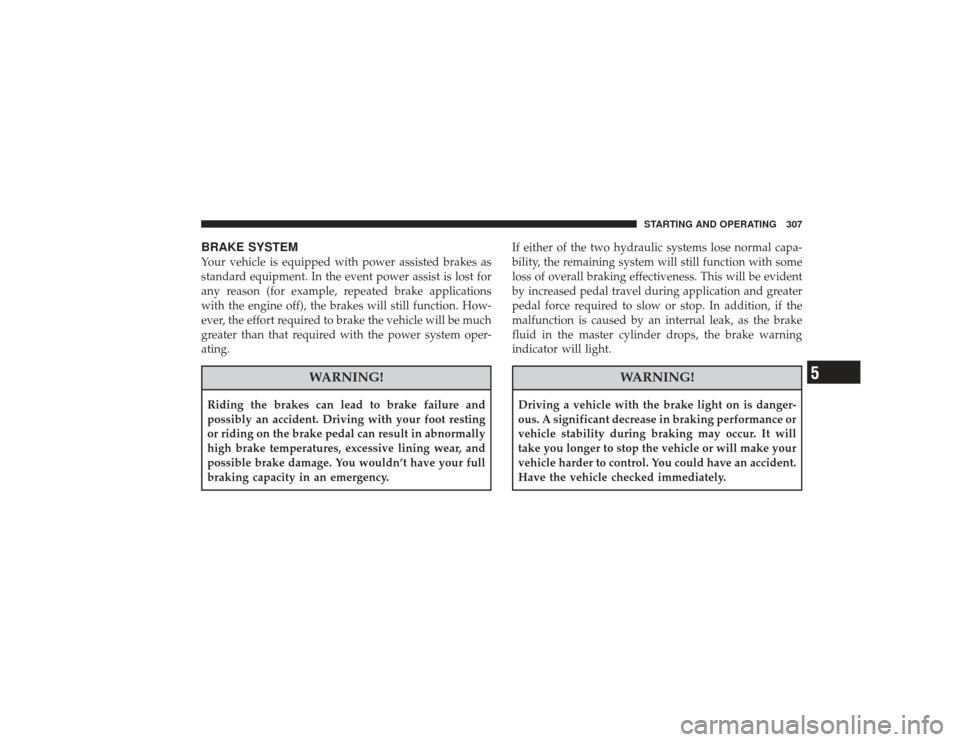
BRAKE SYSTEMYour vehicle is equipped with power assisted brakes as
standard equipment. In the event power assist is lost for
any reason (for example, repeated brake applications
with the engine off), the brakes will still function. How-
ever, the effort required to brake the vehicle will be much
greater than that required with the power system oper-
ating.
WARNING!
Riding the brakes can lead to brake failure and
possibly an accident. Driving with your foot resting
or riding on the brake pedal can result in abnormally
high brake temperatures, excessive lining wear, and
possible brake damage. You wouldn’t have your full
braking capacity in an emergency.If either of the two hydraulic systems lose normal capa-
bility, the remaining system will still function with some
loss of overall braking effectiveness. This will be evident
by increased pedal travel during application and greater
pedal force required to slow or stop. In addition, if the
malfunction is caused by an internal leak, as the brake
fluid in the master cylinder drops, the brake warning
indicator will light.
WARNING!
Driving a vehicle with the brake light on is danger-
ous. A significant decrease in braking performance or
vehicle stability during braking may occur. It will
take you longer to stop the vehicle or will make your
vehicle harder to control. You could have an accident.
Have the vehicle checked immediately.
STARTING AND OPERATING 307
5
Page 310 of 491

ANTI-LOCK BRAKE SYSTEM (ABS) — IF
EQUIPPEDThe ABS provides increased vehicle stability and brake
performance under most braking conditions. The system
automatically “pumps” the brakes during severe braking
conditions to prevent wheel lock-up.
WARNING!
Pumping of the ABS will diminish their effective-
ness and may lead to an accident. Pumping makes
the stopping distance longer. Just press firmly on
your brake pedal when you need to slow down or
stop.
WARNING!
•
The ABS cannot prevent the natural laws of phys-
ics from acting on the vehicle, nor can it increase
braking or steering efficiency beyond that af-
forded by the condition of the vehicle brakes and
tires or the traction afforded.
•
An ABS cannot prevent accidents, including those
resulting from excessive speed in turns, following
another vehicle too closely, or hydroplaning. Only
a safe, attentive, and skillful driver can prevent
accidents.
•
The capabilities of an ABS equipped vehicle must
never be exploited in a reckless or dangerous
manner which could jeopardize the user’s safety
or the safety of others.
308 STARTING AND OPERATING